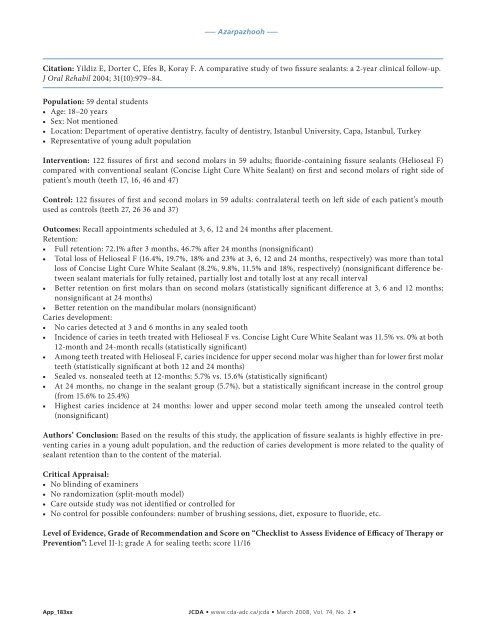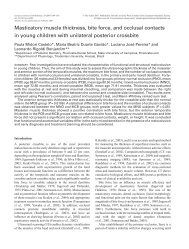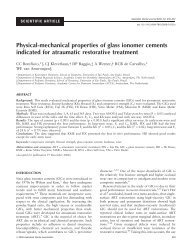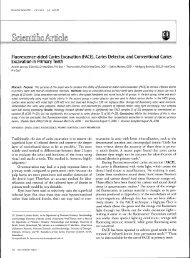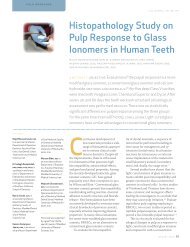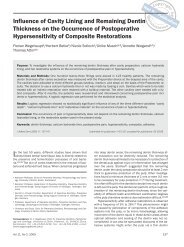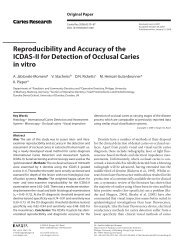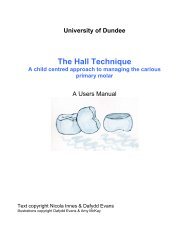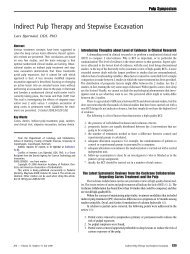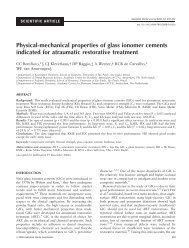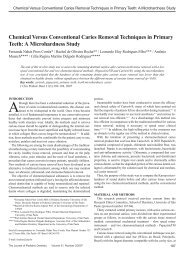Pit and Fissure Sealants in the Prevention of Dental Caries in ...
Pit and Fissure Sealants in the Prevention of Dental Caries in ...
Pit and Fissure Sealants in the Prevention of Dental Caries in ...
Create successful ePaper yourself
Turn your PDF publications into a flip-book with our unique Google optimized e-Paper software.
––– Azarpazhooh –––<br />
Citation: Yildiz E, Dorter C, Efes B, Koray F. A comparative study <strong>of</strong> two fissure sealants: a 2-year cl<strong>in</strong>ical follow-up.<br />
J Oral Rehabil 2004; 31(10):979–84.<br />
Population: 59 dental students<br />
• Age: 18–20 years<br />
• Sex: Not mentioned<br />
• Location: Department <strong>of</strong> operative dentistry, faculty <strong>of</strong> dentistry, Istanbul University, Capa, Istanbul, Turkey<br />
• Representative <strong>of</strong> young adult population<br />
Intervention: 122 fissures <strong>of</strong> first <strong>and</strong> second molars <strong>in</strong> 59 adults; fluoride-conta<strong>in</strong><strong>in</strong>g fissure sealants (Helioseal F)<br />
compared with conventional sealant (Concise Light Cure White Sealant) on first <strong>and</strong> second molars <strong>of</strong> right side <strong>of</strong><br />
patient’s mouth (teeth 17, 16, 46 <strong>and</strong> 47)<br />
Control: 122 fissures <strong>of</strong> first <strong>and</strong> second molars <strong>in</strong> 59 adults: contralateral teeth on left side <strong>of</strong> each patient’s mouth<br />
used as controls (teeth 27, 26 36 <strong>and</strong> 37)<br />
Outcomes: Recall appo<strong>in</strong>tments scheduled at 3, 6, 12 <strong>and</strong> 24 months after placement.<br />
Retention:<br />
• Full retention: 72.1% after 3 months, 46.7% after 24 months (nonsignificant)<br />
• Total loss <strong>of</strong> Helioseal F (16.4%, 19.7%, 18% <strong>and</strong> 23% at 3, 6, 12 <strong>and</strong> 24 months, respectively) was more than total<br />
loss <strong>of</strong> Concise Light Cure White Sealant (8.2%, 9.8%, 11.5% <strong>and</strong> 18%, respectively) (nonsignificant difference between<br />
sealant materials for fully reta<strong>in</strong>ed, partially lost <strong>and</strong> totally lost at any recall <strong>in</strong>terval<br />
• Better retention on first molars than on second molars (statistically significant difference at 3, 6 <strong>and</strong> 12 months;<br />
nonsignificant at 24 months)<br />
• Better retention on <strong>the</strong> m<strong>and</strong>ibular molars (nonsignificant)<br />
<strong>Caries</strong> development:<br />
• No caries detected at 3 <strong>and</strong> 6 months <strong>in</strong> any sealed tooth<br />
• Incidence <strong>of</strong> caries <strong>in</strong> teeth treated with Helioseal F vs. Concise Light Cure White Sealant was 11.5% vs. 0% at both<br />
12-month <strong>and</strong> 24-month recalls (statistically significant)<br />
• Among teeth treated with Helioseal F, caries <strong>in</strong>cidence for upper second molar was higher than for lower first molar<br />
teeth (statistically significant at both 12 <strong>and</strong> 24 months)<br />
• Sealed vs. nonsealed teeth at 12-months: 5.7% vs. 15.6% (statistically significant)<br />
• At 24 months, no change <strong>in</strong> <strong>the</strong> sealant group (5.7%), but a statistically significant <strong>in</strong>crease <strong>in</strong> <strong>the</strong> control group<br />
(from 15.6% to 25.4%)<br />
• Highest caries <strong>in</strong>cidence at 24 months: lower <strong>and</strong> upper second molar teeth among <strong>the</strong> unsealed control teeth<br />
(nonsignificant)<br />
Authors’ Conclusion: Based on <strong>the</strong> results <strong>of</strong> this study, <strong>the</strong> application <strong>of</strong> fissure sealants is highly effective <strong>in</strong> prevent<strong>in</strong>g<br />
caries <strong>in</strong> a young adult population, <strong>and</strong> <strong>the</strong> reduction <strong>of</strong> caries development is more related to <strong>the</strong> quality <strong>of</strong><br />
sealant retention than to <strong>the</strong> content <strong>of</strong> <strong>the</strong> material.<br />
Critical Appraisal:<br />
• No bl<strong>in</strong>d<strong>in</strong>g <strong>of</strong> exam<strong>in</strong>ers<br />
• No r<strong>and</strong>omization (split-mouth model)<br />
• Care outside study was not identified or controlled for<br />
• No control for possible confounders: number <strong>of</strong> brush<strong>in</strong>g sessions, diet, exposure to fluoride, etc.<br />
Level <strong>of</strong> Evidence, Grade <strong>of</strong> Recommendation <strong>and</strong> Score on “Checklist to Assess Evidence <strong>of</strong> Efficacy <strong>of</strong> Therapy or<br />
<strong>Prevention</strong>”: Level II-1; grade A for seal<strong>in</strong>g teeth; score 11/16<br />
App_183xx<br />
JCDA • www.cda-adc.ca/jcda • March 2008, Vol. 74, No. 2 •


